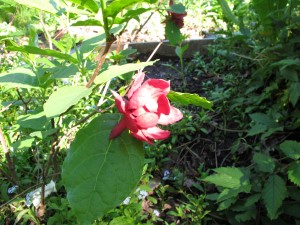Exploring New Trees and Shrubs
Snow has come. The leaves are raked. The garden is as put to bed as it’s going to get. It’s a good time to think about what worked this year and what didn’t. I was pleased with a number of new shrubs that I planted in the last two years and think you might like to keep them in mind next spring when the ground thaws.
The very last shrub that I planted this year was – I have to admit- an impulse buy: scarlet beauty sweetspire (Itea virginica ‘Morton’). I was at E.C. Brown’s Nursery in Thetford, VT (www.ecbrownnursery.com) in mid-November to get a small tree for a special project. And there by the driveway was a shrub that still had its leaves, and they were bright red! I mean as red as burning bush (Euonymus elata) that shrub, loved by many but now banned in most states, that turns a brilliant red in fall. It called to me a soft voice,”I could be yours. I need a home before winter …” So it came home.
According to the tag, it is a medium growing spreading deciduous broadleaf shrub with a height of 3 to 4 feet that spreads 2 to 4 feet. Before I decided on it, I checked my favorite plant reference text, Michael Dirr’s Guide to Woody Landscape Plants. It told me that it is hardy to Zone 5 –safely surviving winters of minus 20 degrees. The plant tag said it was hardy to Zone 4, which means it will survive 30 below zero. I decided to get one, even though we do see temperatures colder than 20 below, on occasion.
Dirr’s book also described the flowers as white, lightly fragrant and about half an inch in diameter, blooming in early summer. He noted that given full sun and plenty of moisture the flowering can be “staggeringly beautiful”. That sounded good to me. Especially since the leaves were dramatic in their fall colors – and I have a nice wet spot near my stream. I am always leery of plants that spread by root, so I ‘ll keep an eye on this one to be sure it doesn’t take over.
Another nice shrub that I got in 2012 that had great fall foliage is the “redbud hazel” (Disanthus cercidifolius). Not a redbud or a hazel, this shrub has leaves that look like redbud leaves. The leaves turn a brilliant red early in the fall, with hints of orange and purple. I planted mine in 2012 and it overwintered nicely, but did not bloom this year. Though as I read Dirr’s book, I now notice that the flowers are “non-showy” half-inch diameter dark purple flowers that appear in October. So maybe there were a few, and I missed them in among the red foliage.
Redbud hazel plants need light to moderate shade, along with deep moist soil that is rich in organic matter and protection from the wind. Mine is suitably planted, and has survived minus 20 degrees. They can grow 6 to 10 feet tall, though mine did not show rapid growth in its first year.
Another nice shrub that I planted in 2012 has many names: Carolina allspice, common sweetbush, sweet Bettie, spicebush and my favorite, sweet bubby. Which is. of course, why plant geeks like me prefer the Latin name: Calycanthys floridus. Don’t be intimidated by Latin nomenclature, just pronounce every letter – and say it with gusto and everyone will be sure you know what you are talking about (that works for me, anyway).
Sweet bubby is, according to the literature, very adaptable: it will grow in sun or shade, acid or alkaline soil. But it does like rich, moist soil and I have plenty of that. I originally planted it in full sun, but the leaves scorched a little that first summer. I assumed that since I had kept it in the pot in a shady spot for a month or more, the scorching was just a reaction to the sudden shift to full sun. But it scorched again this year. So this fall I moved it to light shade near a big old wild apple tree.
The flowers of Calycanthus are striking: deep maroon up to 2-inches across and they can be deliciously fragrant. But not all varieties are fragrant, so if the scent is important to you, buy in early summer when the blossoms are on the plants at the nursery. Some, I have read, may even smell like vinegar. Mine do not have a noticeable fragrance.
I have seen a Calycanthus that was 8 feet tall I in Woodstock, VT, but it was clearly a plant that had been around a long time. Mine has not grown much in the two years I have had it. It can spread 6 to 12 feet, and the two specimens I see regularly seem to be more interested in growing sideways than getting tall.
The only other woody plants I installed this year were a couple of striped or moose maples (Acer pennsylvanicum). This is a small understory tree that I notice in the woods in winter – the bark turns a bright, light green with dark stripes. It is rarely sold in plant nurseries, so grab one if you see it for sale. It is said to grow even in terrible soil conditions, but likes moisture and acidic soil.
We can’t plant anything now, but we can plan and dream.
Henry Homeyer is the author of 4 gardening books and a children’s fantasy-adventure about a boy and a cougar. His web sites are www.henryhomeyer.com and www.gardening-guy.com. He can be reached at PO Box 364, Cornish Flat, NH 03746 or henry.homeyer@comcast.net.




